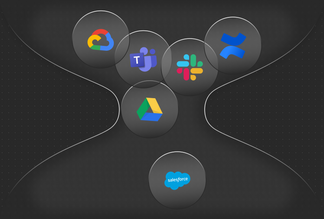

How do you keep track of project links and information?
Why teams need better and quicker access to their files
In recent years, project management tools and applications have multiplied. Hundreds are now on the market, with workplaces, teams, and employees often working across various platforms to manage and share files, to track project links, and to check project status.
Despite the wealth of tools on offer, 60% of software companies we spoke to still have no visibility on their colleagues’ work. The same research shows that 7 out of 10 software companies spend too much time searching for information. Links and files are falling through the cracks between tools and teams—at significant costs to organizations.
The shift to remote working means there’s greater urgency to keep track of project links across teams. In this post, we’ll look at why easy access to these resources isn’t a luxury—it is a central element of efficient project management in today’s workplace.
Why too many project management tools hinder workplace collaboration
Project management software was designed to make sharing information and tracking projects easier. Yet, the rapid growth of these services in the past decade can actually threaten how smoothly your team operates.
There are now over 300 SaaS tools in the project management space alone. Asana, Trello, JIRA, and Basecamp, to name just a few. And there are a whole bunch of connected tools, such as Google Drive, Notion, and GitHub. According to Forbes, the average company is now using over 30 SaaS tools—and often with some overlapping functionalities.
The decentralisation of IT budgets is the main driver of this, with more than half of this budget now managed by individual teams in most organizations. While this gives them a greater freedom, teams are investing in their own tools and software for tracking projects—without knowing what other teams are using.
As a result, a fragmented work environment has emerged. Product leads can’t find the engineers’ task lists and the growth team doesn't have easy visibility on the UX designer’s progress.
1. Collaborating within a new work environment
Unfortunately, cross-functional collaboration already has enough on its plate. Research in the Harvard Business Review found that 75% of cross-department teams are already suffering, due to difficulties in communicating the roles, needs, and priorities of others.
At the same time, cross-team collaboration is on the rise—and remote work is adding to the complexity of relations between functions. In this environment, a fragmented workflow caused by competing tools and processes will become even more of a problem. And the need for a more holistic project tracking will become more important than ever.
2. Cluttered workflows disrupt productivity, focus, and efficiency
The diversity of project management tools isn’t simply an abstract problem. Rather, orienting yourself in a cluttered work environment is a genuine drain on energy and time. By using bandwidth keeping track of files, documents, and project links, you’re diverting attention from more productive work, interrupting focus, and disrupting flow.
And employees don’t always succeed, either: even back in 2012, when we didn’t have this many productivity apps and we were consuming less information in the workspace a survey found that two hours a week are lost per head in searching for digital documents that are never located.
As a result, employee time is spent building their own landmarks on this terrain. They create expensive and tailor-made workarounds—like bookmarks and links lists—to locate documents across project tracking tools. But these navigation options aren’t always shareable, scalable, or even comprehensible to others. Within one context, they may make sense. But when project links are loose from that context, information soon becomes confusing.
This problem becomes more significant as workforces shift to remote. When links can’t be found, it’s natural to ask someone. But message pings are disruptive, and according to our research, half of employees we spoke to think there’s too much noise in the team comms already.
3. The costs of inefficient project management
It’s not just individuals that are impacted by this sort of inefficiency. Organizations as a whole suffer from the friction in their project management structures and processes.
More time and money gets wasted with every workaround that gets developed and with every band-aid that gets applied. Often, an organization will build their own infrastructure from scratch to link up different platforms and tools—which means yet more energy (and budget) is distracted away from developing the products and features that are meant to build instead.
And these band-aid solutions tend to miss the deeper point: project links and other resources should be managed better from the start, with quick access to them built into a virtual workspace that promotes transparency and collaboration between your teams.
How can organizations improve tracking of project links?
The future of work is remote. And, in this new paradigm, the organizations that thrive will be the ones that collaborate and communicate smoothly online. Quick access to shared resources can’t be a luxury. But as SaaS productivity & collaboration tools continue to gain a foothold, we need new ways to manage proliferation of project links, documents, and resources across software.
The answer is to use a central work hub—a virtual workspace that forms the single source of truth for all projects, connecting tools and people in one place. Having a searchable environment means project links don’t get lost in silos, and your teams can focus on the vital tasks that impact your growth.



